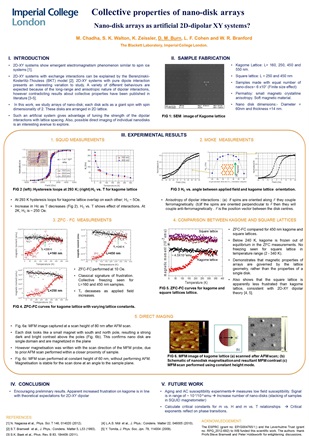
Collective properties of frustrated nano-disk arrays
M. Chadha, S.K. Walton, K. Zeissler, D.M. Burn, L.F. Cohen and W.R. Branford
IoP Magnetism Leeds Mar 2015
We present SQUID and MOKE magnetometry and MFM imaging experiments on arrays consisting of ~106 single domain permalloy nano-disks with 60 nm diameter. The nano-disks were fabricated with different array geometries and varying disk separations. This was done to test whether nano-disk arrays can be well described as an artificial 2D-XY dipolar system [1-3]. The 2D-XY system with exchange interactions has been well understood by the Berenzinskii-Kosterlitz-Thouless (BKT) model [4, 5], and the 2D-XY system with purely dipolar interaction presents an interesting variation to study. A variety of differences are expected because dipolar interactions are long-range and anisotropic in nature, however, contradicting results about collective properties have been published in literature [1-3].
In this work, we study kagome and square lattices with lattice spacing varying from 160 to 450 nm. MFM imaging shows that the individual disks of this diameter are single domain and with approximately uniform magnetisation and without significant in-plane anisotropy. Zero field-cooled and field-cooled magnetometry measurements on the kagome and square lattices were performed. The kagome lattice shows a cooperative freezing transition while square lattice shows no such transition in the temperature range studied (2 - 300 K). This demonstrates that the magnetic properties of our arrays are governed by the lattice geometry, rather than the properties of a single disk. The observation that the square lattice is apparently less frustrated than kagome lattice is consistent with 2D-XY dipolar theory [3, 6]. Additionally, we explore the collective properties as a function of lattice spacing, to tune the dipolar interaction strength.
[1] A. Carbognani, E. Rastelli, S. Regina, and A. Tassi, Phys. Rev. B 62, 1015 (2000).
[2] S.K. Baek, P. Minnhagen, and B.J. Kim, Phys. Rev. B 83,184409 (2011).
[3] L.A.S. Mól and B.V. Costa, J. Phys.: Condens. Matter 22, 046005 (2010).
[4] S.T. Bramwell and P.C.W. Holdsworth, J. Phys.: Condens. Matter 5, L53 (1993).
[5] S.T. Bramwell, P. Day, M.T. Hutchings, J.R.G. Thorn